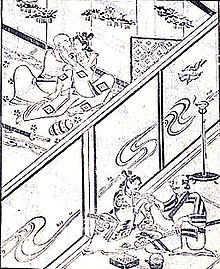Wakashudō
Wakashudō ( jpn. 若衆道 , literally "the way of the young men"), also briefly shudo ( 衆道 ) or Nyakudō ( 若道 ) is an erotic teacher-student ratio, the central part of the education of a young man to the Samurai was .
The name Bidō ( 美 道 , dt .: "the beautiful way") was also in use. In contrast to the ancient Greek pederasty , in Japan the initiative to enter into such a relationship was expected from the boy. Often, however, the student was very young at the beginning of Wakashudō (between 10 and 13 years), which is why it can be assumed that the parents usually chose the teacher.
During the entire apprenticeship, teachers and students lived together. The student was mainly instructed in martial arts and educated according to the Bushidō , the samurai's philosophy of life. The sexual relationship usually ended with the end of the training at the age of around 19 and the teacher-student relationship then often turned into a lifelong friendship or father-son relationship.
Wakashudō appeared for the first time in the 12th century and was a common practice until the decline of samurai culture in the 19th century and was fully accepted by society, not least because of the poor position of women. The origins of this practice can be traced back to similar relationships between friars and their students, as first documented in Japan around the 10th century.
